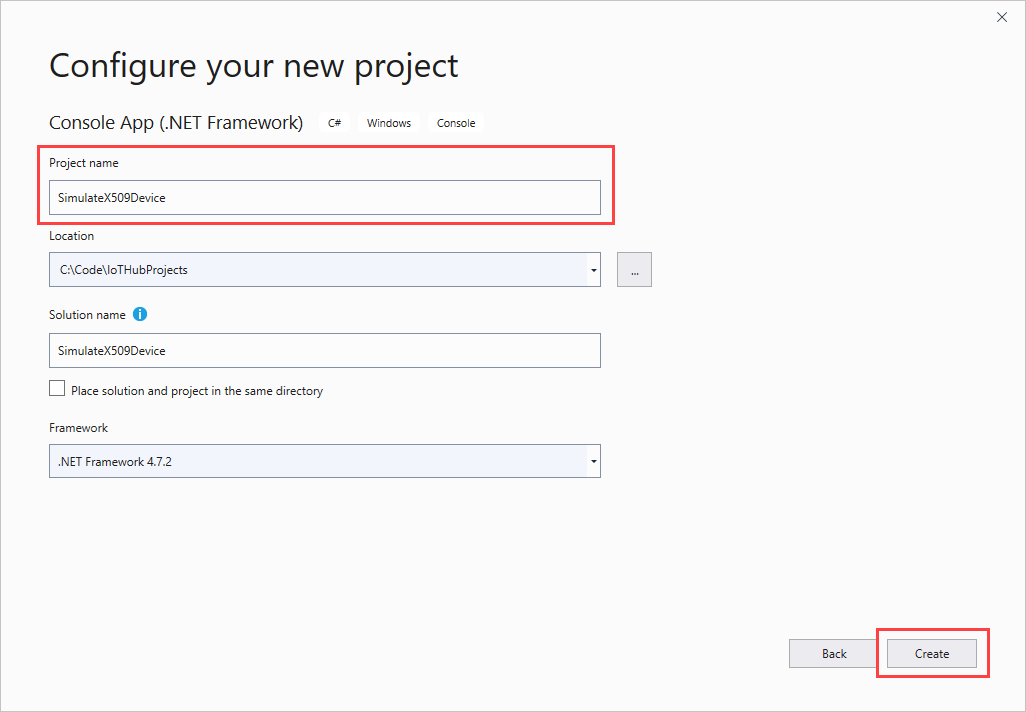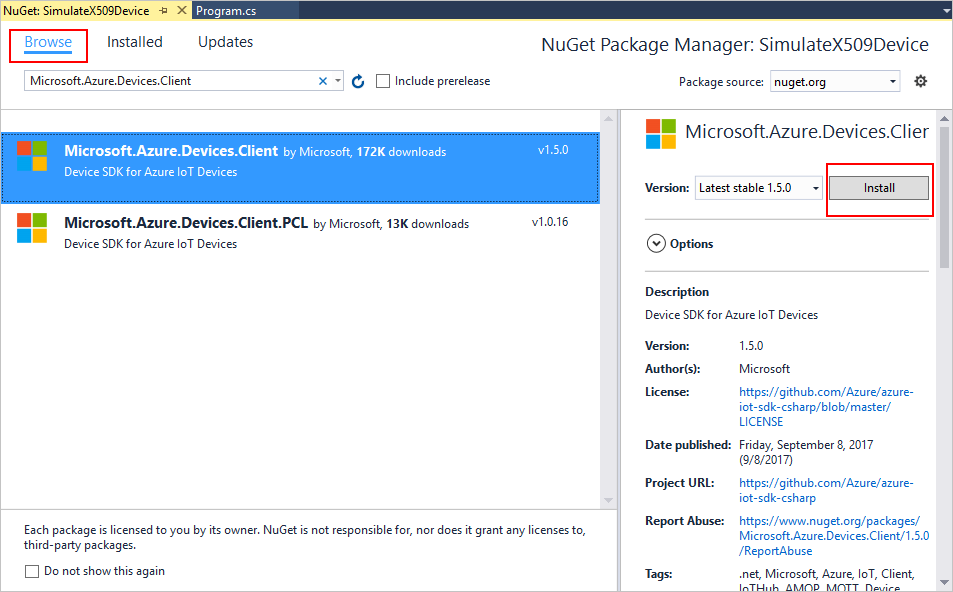Note
Access to this page requires authorization. You can try signing in or changing directories.
Access to this page requires authorization. You can try changing directories.
You can use the following C# code example to test that your certificate can authenticate your device to your IoT Hub. Note that you must do the following before you run the test code:
- Create a root CA or subordinate CA certificate.
- Upload your CA certificate to your IoT Hub.
- Prove that you possess the CA certificate.
- Add a device to your IoT Hub.
- Create a device certificate with the same device ID as your your device.
Important
The authentication process checks that your device is associated with the correct IoT Hub name.
Code Example
The following code example shows how to create a C# application to simulate the X.509 device registered for your IoT hub. The example sends temperature and humidity values from the simulated device to your hub. In this tutorial, we will create only the device application. It is left as an exercise to the readers to create the IoT Hub service application that will send responses to the events sent by this simulated device.
Open Visual Studio, select Create a new project, and then choose the Console App (.NET Framework) project template. Select Next.
In Configure your new project, name the project SimulateX509Device, and then select Create.

In Solution Explorer, right-click the SimulateX509Device project, and then select Manage NuGet Packages.
In the NuGet Package Manager, select Browse and search for and choose Microsoft.Azure.Devices.Client. Select Install.

This step downloads, installs, and adds a reference to the Azure IoT device SDK NuGet package and its dependencies.
Input and run the following code:
using System;
using Microsoft.Azure.Devices.Client;
using System.Security.Cryptography.X509Certificates;
using System.Threading.Tasks;
using System.Text;
namespace SimulateX509Device
{
class Program
{
private static int MESSAGE_COUNT = 5;
// Temperature and humidity variables.
private const int TEMPERATURE_THRESHOLD = 30;
private static float temperature;
private static float humidity;
private static Random rnd = new Random();
// Set the device ID to the name (device identifier) of your device.
private static String deviceId = "{your-device-id}";
static async Task SendEvent(DeviceClient deviceClient)
{
string dataBuffer;
Console.WriteLine("Device sending {0} messages to IoTHub...\n", MESSAGE_COUNT);
// Iterate MESSAGE_COUNT times to set randomm termperature and humidity values.
for (int count = 0; count < MESSAGE_COUNT; count++)
{
// Set random values for temperature and humidity.
temperature = rnd.Next(20, 35);
humidity = rnd.Next(60, 80);
dataBuffer = string.Format("{{\"deviceId\":\"{0}\",\"messageId\":{1},\"temperature\":{2},\"humidity\":{3}}}", deviceId, count, temperature, humidity);
Message eventMessage = new Message(Encoding.UTF8.GetBytes(dataBuffer));
eventMessage.Properties.Add("temperatureAlert", (temperature > TEMPERATURE_THRESHOLD) ? "true" : "false");
Console.WriteLine("\t{0}> Sending message: {1}, Data: [{2}]", DateTime.Now.ToLocalTime(), count, dataBuffer);
// Send to IoT Hub.
await deviceClient.SendEventAsync(eventMessage);
}
}
static void Main(string[] args)
{
try
{
// Create an X.509 certificate object.
var cert = new X509Certificate2(@"{full path to pfx certificate.pfx}", "{your certificate password}");
// Create an authentication object using your X.509 certificate.
var auth = new DeviceAuthenticationWithX509Certificate("{your-device-id}", cert);
// Create the device client.
var deviceClient = DeviceClient.Create("{your-IoT-Hub-name}.azure-devices.net", auth, TransportType.Mqtt);
if (deviceClient == null)
{
Console.WriteLine("Failed to create DeviceClient!");
}
else
{
Console.WriteLine("Successfully created DeviceClient!");
SendEvent(deviceClient).Wait();
}
Console.WriteLine("Exiting...\n");
}
catch (Exception ex)
{
Console.WriteLine("Error in sample: {0}", ex.Message);
}
}
}
}